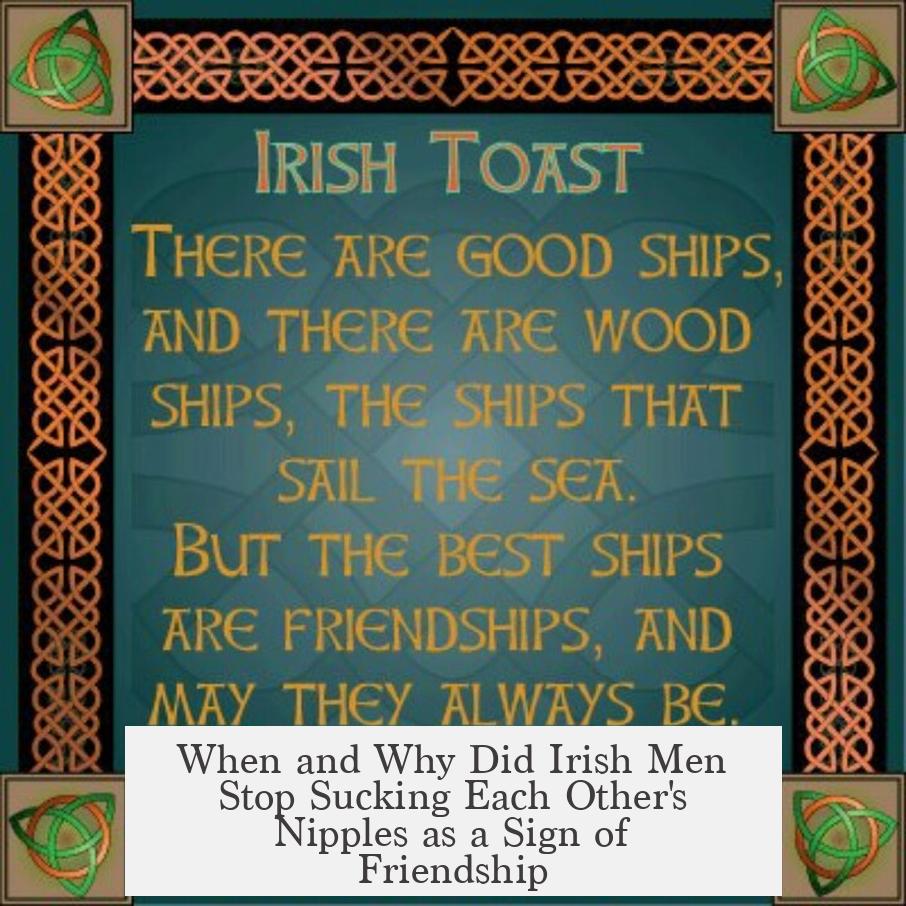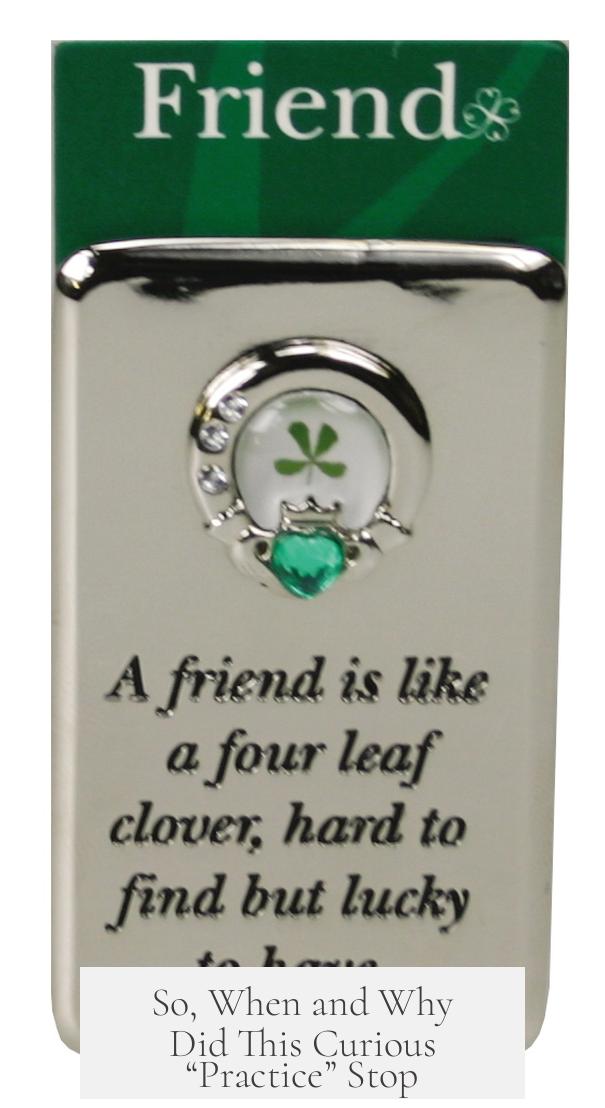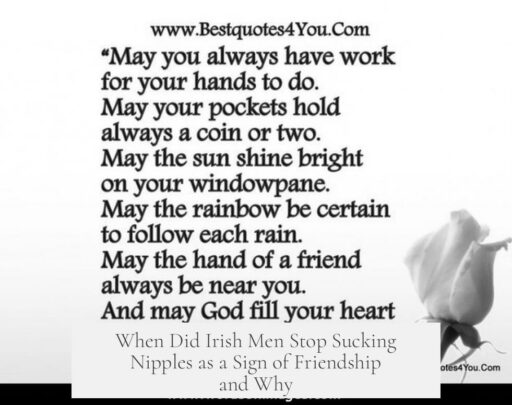Irish men did not historically stop sucking each other’s nipples as a sign of friendship because there is no strong evidence that this practice ever genuinely existed as a social ritual in Ireland. The idea likely stems from misinterpretations of medieval texts and Biblical metaphors rather than any actual physical custom among Irish men.
Historical and literary sources on early Irish customs provide no clear examples of nipple sucking as a friendship gesture. The only potential reference appears in The Saga of Fergus mac Léti, where a dwarf is said to “suck” Fergus’ nipple as a plea for mercy. However, this passage is highly disputed among scholars. Early versions do not mention nipple sucking explicitly and describe the dwarf grabbing Fergus’ cheeks instead. Linguistic analyses highlight translation ambiguities in the original Irish text. For instance, the phrase describing the dwarf’s action can be interpreted as “being on Fergus’ chest” or a different meaning altogether, not necessarily sucking a nipple.
Additionally, common Irish idioms involve the word “breast” (cích), but these appear as metaphors for loyalty or hospitality, not evidence of a physical act. Similar idioms appear in English, such as “bosom friend,” without implying an actual nipple-sucking practice. This suggests that references to breasts in medieval Irish texts are symbolic rather than literal.
The belief that Irish men engaged in nipple sucking as a friendship sign may also derive from St. Patrick’s Confessio. Patrick recounts refusing to perform a “gesture of friendship” involving breast sucking to an Irish captain. Modern scholarship understands this as Patrick employing Biblical imagery rather than describing a real cultural custom. His phrasing echoes Biblical passages portraying God as a nursing mother, symbolizing spiritual relationships rather than physical rituals.
Other physically attested gestures of friendship or supplication in Irish tradition involve grabbing someone by the cheeks or earlobes. These acts appear repeatedly in texts spanning centuries and seem to have had more solid social significance. Such gestures were used to indicate a plea for mercy or a challenge to honor, contrasting sharply with the dubious nipple-sucking claim.
No records exist detailing when or why nipple sucking as a sign of friendship might have ceased in Ireland. This absence is consistent with the broader view that the practice was never a genuine custom. The myth likely emerged through translation errors, metaphorical language, and modern misreadings of medieval sources.
| Claim | Evidence | Scholarly View |
|---|---|---|
| Nipple sucking was a friendly gesture | One line in The Saga of Fergus mac Léti | Likely mistranslation or metaphorical; not a confirmed practice |
| Patrick performed or refused nipple sucking | St. Patrick’s Confessio | Metaphorical/Biblical imagery, not literal custom |
| Grabbing cheeks or earlobes denotes friendship | Numerous medieval texts | Widely accepted genuine social gesture |
In sum, the concept that Irish men historically sucked each other’s nipples to signify friendship is a modern misconception.
- Only one ambiguous medieval reference suggests nipple sucking, likely mistranslated or symbolic.
- St. Patrick’s writing uses Biblical metaphor rather than describing an Irish social custom.
- Cheek or earlobe grasping is a historically attested gesture of supplication or friendship.
- No factual evidence exists for the practice or its abandonment.
When and Why Did Irish Men Stop Sucking Each Other’s Nipples as a Sign of Friendship?

Here’s the kicker: Irish men probably never seriously engaged in sucking each other’s nipples as a sign of friendship—period. The idea is more myth than fact, born from a tangle of shaky translations, metaphoric religious language, and later misinterpretations. So, if you’re imagining ancient Irish chums bonding over a good old nipple-suck, prepare for a history lesson that’s a bit less cheeky and a lot more about linguistic twists.
Feeling let down? Don’t be! The story behind this peculiar question is fascinating, revealing much about how language, culture, and history intersect—and sometimes mislead us. Let’s dive deeper.
The Elusive Origins of the Nipple-Sucking Myth
First off, the claim that Irish men once sucked each other’s nipples as a friendship ritual mostly springs from a single line in The Saga of Fergus mac Léti. This is an old Irish tale where Fergus battles three dwarfs. One dwarf allegedly begs for mercy by—wait for it—sucking Fergus’s nipple. Sounds bizarre and compelling, but this is that rare kind of case where the devil is in the translation details.
Scholars like Sharon Arbuthnot point out that earlier versions of the saga don’t mention nipple-sucking. Instead, the dwarf “grabbed” Fergus’s cheeks. The phrase that supposedly means “the dwarf sucked Fergus’s nipple” can actually mean quite a few things, including simply “the dwarf was on Fergus’s chest” or “therefore the dwarf was on Fergus’s chest.”
In short, the phrase is ambiguous. The original medieval Irish wording is tricky and supports multiple interpretations. So rather than a social custom, this might be a metaphor, misunderstanding, or mistranslation.
St Patrick’s Confessio: A Biblical Metaphor Misread as History
If you trace the nipple-sucking myth further back, it’s often linked to a line in St Patrick’s Confessio. Patrick tells of refusing to suck the breasts of an Irish captain as a sign of friendship. This is frequently quoted as proof of the practice.
But here’s the catch: Patrick’s writing is drenched in biblical imagery, and the Latin expression he uses echoes texts where God is portrayed as a nursing mother, and the Irish people as His child. It’s a metaphor, not a social custom. Patrick denied the act symbolically to assert his Christian faith and independence, not to reject a genuine pagan ritual.
In other words, Patrick’s refusal was probably a figurative rejection of pagan dependence rather than a literal refusal of nipple-sucking.
More Reliable Gestures of Friendship in Irish Tradition
The real, well-documented gestures of friendship and supplication in Irish history are different—and frankly, much more conventional. Grabbing someone’s cheeks or earlobes to beg for mercy or show respect appears repeatedly in medieval Irish sources.
This physical gesture was widespread, well-understood, and attested many times. It was a social signal of honour and appeal. So if anyone was grabbing each other in physically intimate ways, it was mostly the cheeks or ears, not nipples.
So, When and Why Did This Curious “Practice” Stop?

Here’s where the mystery thickens: we have absolutely no record or solid source telling us that nipple-sucking was ever common as a friendship ritual among Irish men. Therefore, there’s no documented point in time when it “stopped,” nor any reason given for its cessation. It likely never officially started.
Think about it: historic cultures often leave behind records when a physical or social practice is common and important. With something as bold as nipple-sucking, especially as a male bonding ritual, one would expect some clearer evidence—art, laws, repeated mentions in literature. But there’s nothing solid.
This absence also helps explain why modern Ireland doesn’t include such rituals in its historical narratives. The myth has simply worn away as scholarship demystifies old texts.
Why Does This Myth Persist Then?
Human nature loves quirky, unexpected stories about the past. The nipple-sucking narrative safe-guards a sort of strange fascination with the exotic or taboo. Similarly, mistranslations and metaphorical writings invite legend-building.
Also, humorous or awkward interpretations get retold because they stick in the mind. Imagine the stories at the pub! No wonder it grabs attention, even if it’s an academic red herring.
Examples and Comparisons: Grabbing Cheeks vs. Sucking Nipples
- Grabbing cheeks or ears: An accepted and attested gesture that signals respect, friendship, or plea for mercy. Multiple texts across centuries support this.
- Nipple-sucking: Limited to ambiguous, ambiguous, and mostly singular references. No image or poem robustly confirms it.
This difference is critical. Grabbing cheeks is tangible and well-understood, nipple-sucking is speculative at best.
What Can Modern Readers Learn from This Confusing Tale?
1. Don’t trust a single source blindly. Especially when translations involve ancient languages with many possible meanings.
2. Context is king. Patrick’s Confessio isn’t a travel diary but a spiritual and literary text full of biblical allusions.
3. Misinterpretations often arise from combining metaphor with literal readings. What sounds wild may just be colorful metaphor.
4. Cultural rituals often evolve slowly. Absence of evidence for a practice usually means it wasn’t widespread or central.
Final Thoughts: The Nipple-Sucking Myth vs. Reality
The story about Irish men sucking each others’ nipples as a sign of friendship probably belongs in the “great history myths” file. It’s a fun legend but lacks hard evidence. Instead, Irish bonds were likely expressed via more conventional and repeated gestures like grabbing cheeks or ears.
So next time you hear someone talk about this “ancient Irish friendship ritual,” politely smile and know that it’s more literary curiosity than historic fact. Instead of nipple-sucking, why not celebrate the genuine customs of loyalty and respect that truly shaped Irish culture—and maybe share a friendly handshake instead?
“There is no evidence that Irish men ever regularly sucked each other’s nipples as a friendship sign. It’s probably a mix-up of translation, metaphor, and myth.” — From extensive examination of medieval Irish texts




